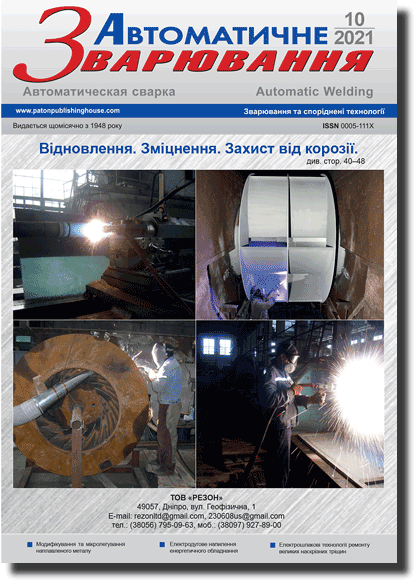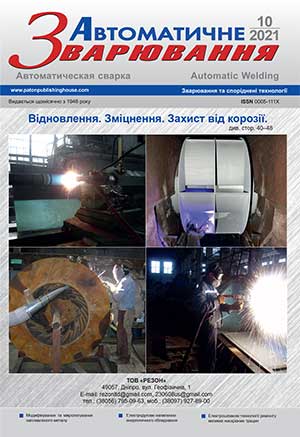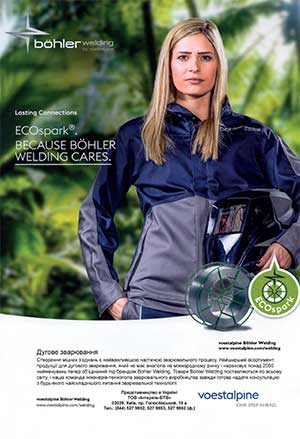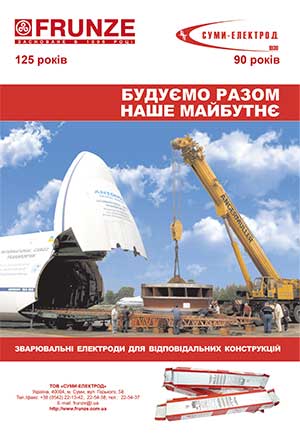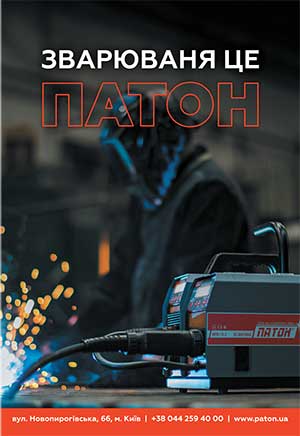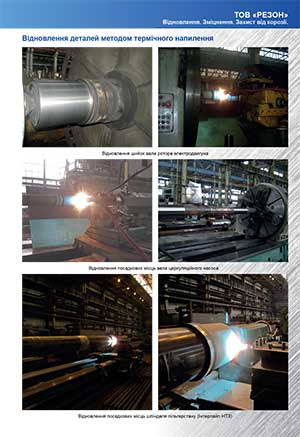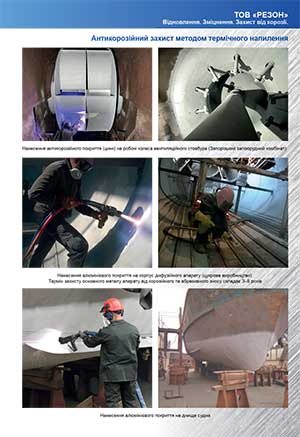Access for download PDF files for subscribers and for reviewers of scientometric bases.
Organization: Elsevier for content access(PDF files of journals released before 2024 are available for download from the website's archives))
Organization: Elsevier for content access(PDF files of journals released before 2024 are available for download from the website's archives))
| 2021 №10 (01) |
DOI of Article 10.37434/as2021.10.02 |
2021 №10 (03) |
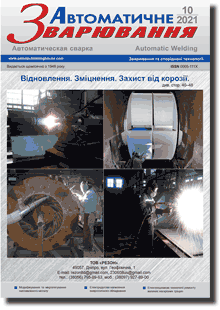
"Avtomatychne Zvaryuvannya" (Automatic Welding), #10, 2021, pp. 12-18
Structural inhomogeneity in welded joints of heat-resistant steels of chromium-molybdenum-vanadium
M.O. Nimko, V.Y. Skulskyi, A.R. Gavrik, S.I. Moravetskyi, I.G. Osipenko
E.O. Paton Electric Welding Institute of the NAS of Ukraine. 11 Kazymyr Malevych Str., 03150, Kyiv, Ukraine. E-mail: office@paton.kiev.ua
Welded joints of dissimilar steels are widely used in different assemblies of the steam-water mixture loop in electric power plants. The difference in alloying by chromium and other carbide-forming elements results in carbon migration from the lower alloyed to higher alloyed steel in such joints after tempering and in high-temperature service. Decarbonization in the HAZ near-weld zone can lead to formation of defects and subsequent failures. In this work we studied the infl uence of the type of 15Kh2M2FBS steel joint (single-pass, multipass), made using electrodes with 9 % Cr, on the nature of formation and development of structural inhomogeneity in the HAZ at high-temperature annealing. It is shown that depending on joint type, development of ferrite interlayer takes place in different zones of the HAZ: in the normalized zone and in the zone of intercritical temperatures АС1-АС3 at a distance from the fusion line at single-pass welding; and in the near-weld zone through the HAZ coarse-grained region at multipass welding. Proceeding from the features of decarbonizastion on the surfaces of butt joints and near the fusion line, a scheme was proposed, that allows explaining the nature of development of structural inhomogneneity in the multipass joint of dissimilar steels. 17 Ref., 11 Fig.
Keywords: carbon diffusion, dissimilar steel joints, heat-affected zone, decarbonized interlayer
Received: 22.07.2021
References
1. Di Gianfrancesco, A. (2017) Materials for Ultra-Supercritical and Advanced Ultra-Supercritical Power Plants. Woodhead Publishing.2. DuPont, J.N. (2012) Microstructural evolution and high temperature failure of ferritic to austenitic dissimilar welds. International Materials Reviews, 57 (4), 208-234. https://doi.org/10.1179/1743280412Y.0000000006
3. Gotalsky, Yu.N. (1981) Welding of dissimilar steels. Kiev, Tekhnika [in Russian].
4. Helander, T., Andersson, H. C. M., Oskarsson, M. (2000) Structural changes in 12-2.25% Cr weldments - an experimental and theoretical approach. Materials at High Temperatures, 17 (3), 389-396. https://doi.org/10.1179/mht.2000.17.3.003
5. Zhao, Y., Gong, J., Wang, X. et al. (2015) Carbon diffusion in dissimilar joints between P91 and 12Cr1MoV steels welded by different consumables at high temperature. Ibid, 32 (6), 557-565. https://doi.org/10.1179/1878641315Y.0000000002
6. Khromchenko, F.A. (2010) Peculiarities and causes of damages of pipeline welded joints (Background materials). Moscow, STC Energoprogress [in Russian].
7. Jandová, D., Kasl, J., Kanta, V. (2006) Creep resistance of similar and dissimilar weld joints of P91 steel. Materials At High Temperatures, 23 (3/4), 165-170 https://doi.org/10.3184/096034006782739231
8. Mayr, P., Schlacher, C., Siefert, J. A., Parker, J. D. (2018) Microstructural features, mechanical properties and high temperature failures of ferritic to ferritic dissimilar welds. International Materials Reviews, 64 (1), 1-26. https://doi.org/10.1080/09506608.2017.1410943
9. Dawson, K. E., Tatlock, G. J., Chi, K., Barnard, P. (2013) Changes in precipitate distributions and the microstructural evolution of P24/P91 dissimilar metal welds during PWHT. Metallurgical And Materials Transactions A, 44, 5065-5080. https://doi.org/10.1007/s11661-013-1880-y
10. Laha, K., Chandravathi, K.S., Bhanu Sankara Rao, K. et al. (2001) An assessment of creep deformation and fracture behavior of 2,25Cr-1Mo similar and dissimilar weld joints. Ibid, 32A, 115-124. https://doi.org/10.1007/s11661-001-0107-9
11. Brett, S.J. (2004) Type IIIa cracking in 1/2CrMoV steam pipework systems. Science and Technology of Welding and Joining, 9 (1), 41-45. https://doi.org/10.1179/136217104225017134
12. Cerjak, H., Mayr, P. (2008) «Creep strength of welded joints of ferritic steels» in Creep-resistant steels. Edited by Abe, F., Kern, T.-U., Viswanathan, R., Woodhead Publishing. https://doi.org/10.1533/9781845694012.2.472
13. Hrivnak, I., Malinovska, E., Mosny, Ya. (1983) To problem of formation of «white layer» in narrow-gap submerged arc welding. VUZ, XIX, 1.
14. German, S.I. (1972) Electric arc welding of heat-resistant steels of pearlite class. Moscow, Mashinostroenie [in Russian].
15. Lundin, C.D., Khan, K.K., Yang, D. (1995) Effect of carbon migration in Cr-Mo weldments on metallurgical structure and mechanical properties. Welding Research Council Bulletin, 407, 1-49.
16. Mehrer, H. (2007) Diffusion in Solids. Fundamentals, Methods, Materials, Diffusion-Controlled Processes. Springer-Verlag. https://doi.org/10.1007/978-3-540-71488-0
17. Laha, K., Chandravathi, K.S., Parameswaran, P. Et al. (2007) Characterization of microstructures across the heat-affected zone of the modified 9Cr-1Mo weld joint to understand its role in promoting type IV cracking. Metallurgical And Materials Transactions A, 38A, 58-67. https://doi.org/10.1007/s11661-006-9050-0
Advertising in this issue:
The cost of subscription/purchase order journals or individual articles
| Journal/Currency | Annual Set | 1 issue printed |
1 issue |
one article |
| TPWJ/USD | 384 $ | 32 $ | 26 $ | 13 $ |
| TPWJ/EUR | 348 € | 29 € | 24 € | 12 € |
| TPWJ/UAH | 7200 UAH | 600 UAH | 600 UAH | 280 UAH |
| AS/UAH | 1800 UAH | 300 UAH | 300 UAH | 150 UAH |
| AS/USD | 192 $ | 32 $ | 26 $ | 13 $ |
| AS/EUR | 180 € | 30 € | 25 € | 12 € |
| SEM/UAH | 1200 UAH | 300 UAH | 300 UAH | 150 UAH |
| SEM/USD | 128 $ | 32 $ | 26 $ | 13 $ |
| SEM/EUR | 120 € | 30 € | 25 € | 12 € |
| TDNK/UAH | 1200 UAH | 300 UAH | 300 UAH | 150 UAH |
| TDNK/USD | 128 $ | 32 $ | 26 $ | 13 $ |
| TDNK/EUR | 120 € | 30 € | 25 € | 15 € |
AS = «Automatic Welding» - 6 issues per year;
TPWJ = «PATON WELDING JOURNAL» - 12 issues per year;
SEM = «Electrometallurgy Today» - 4 issues per year;
TDNK = «Technical Diagnostics and Non-Destructive Testing» - 4 issues per year.





